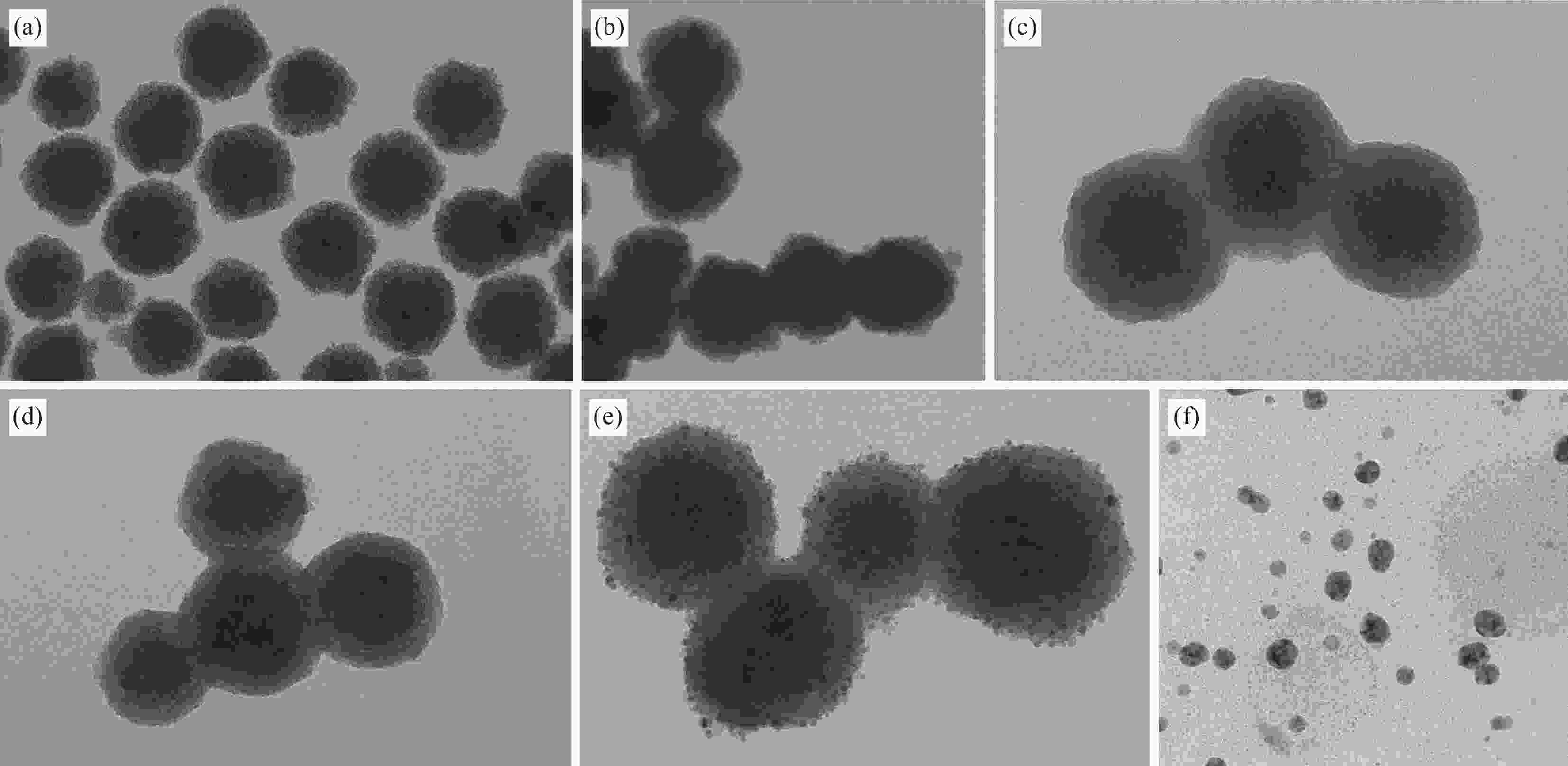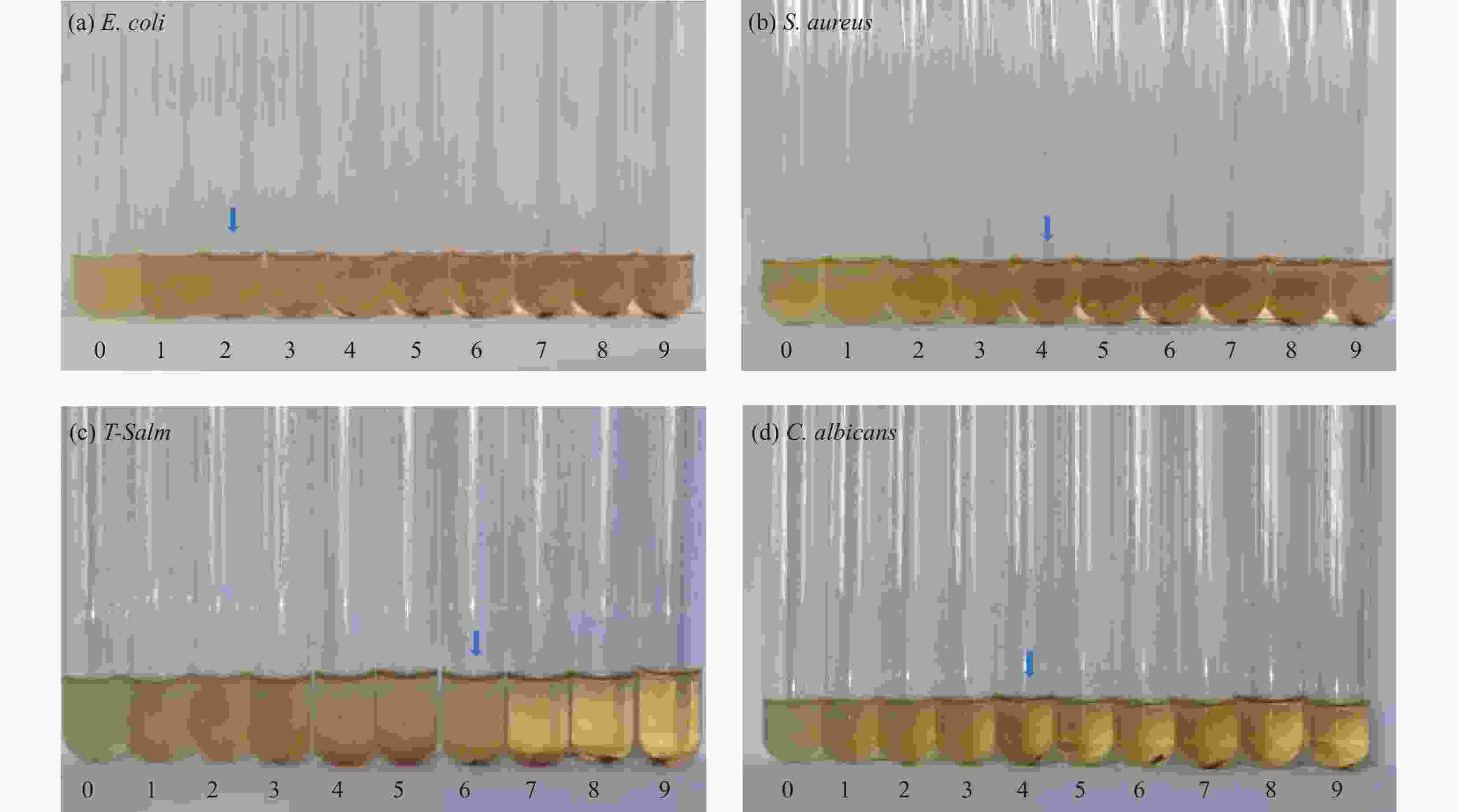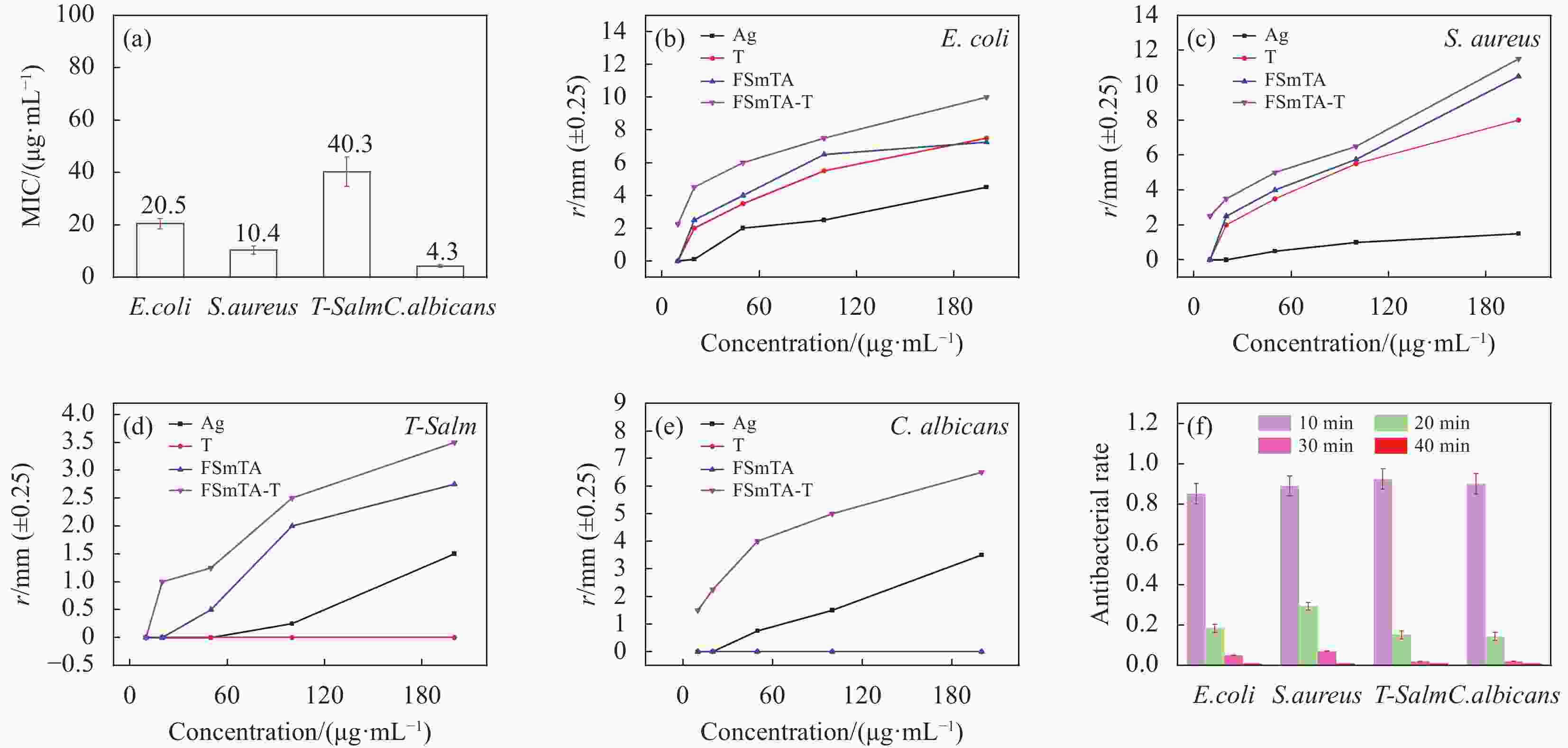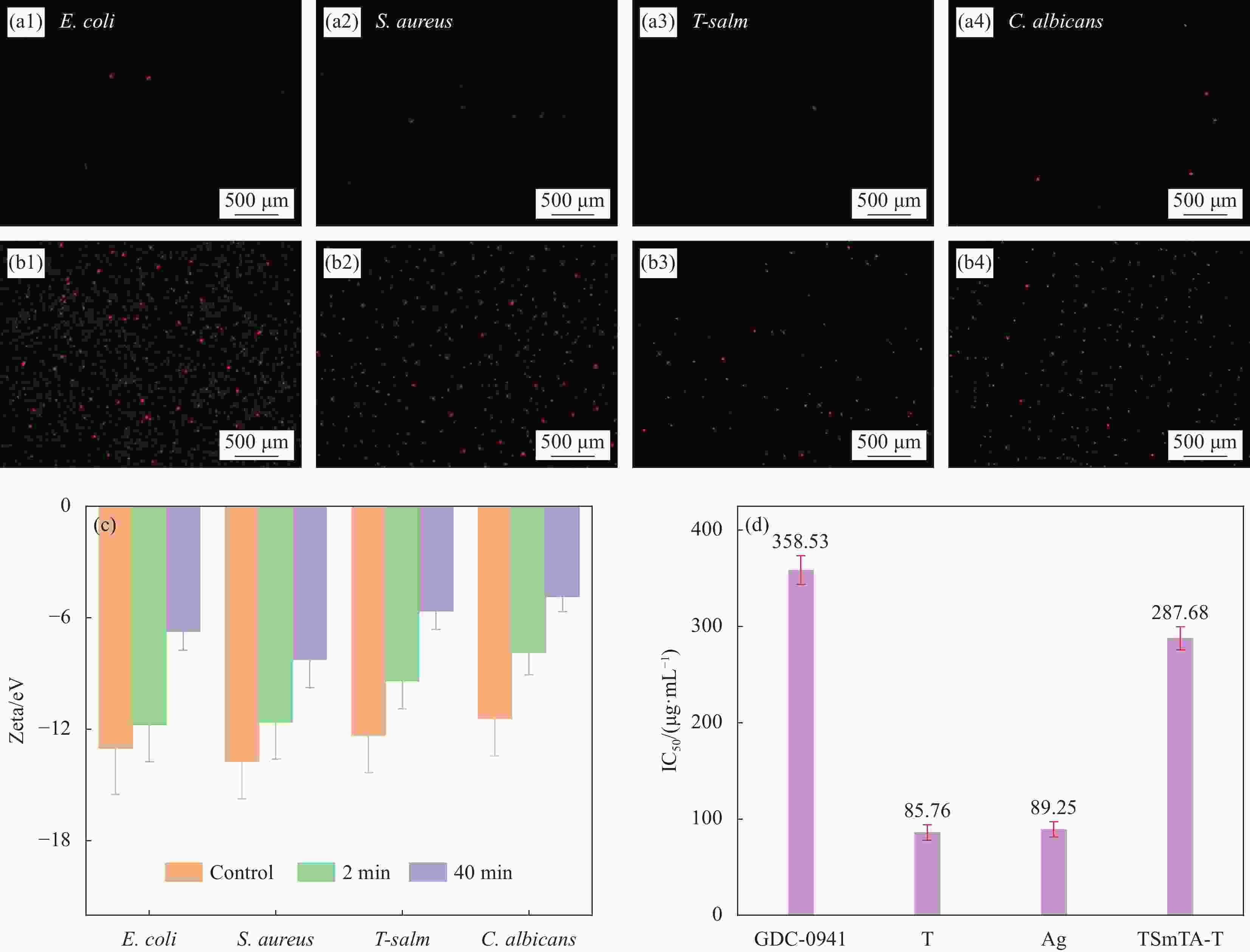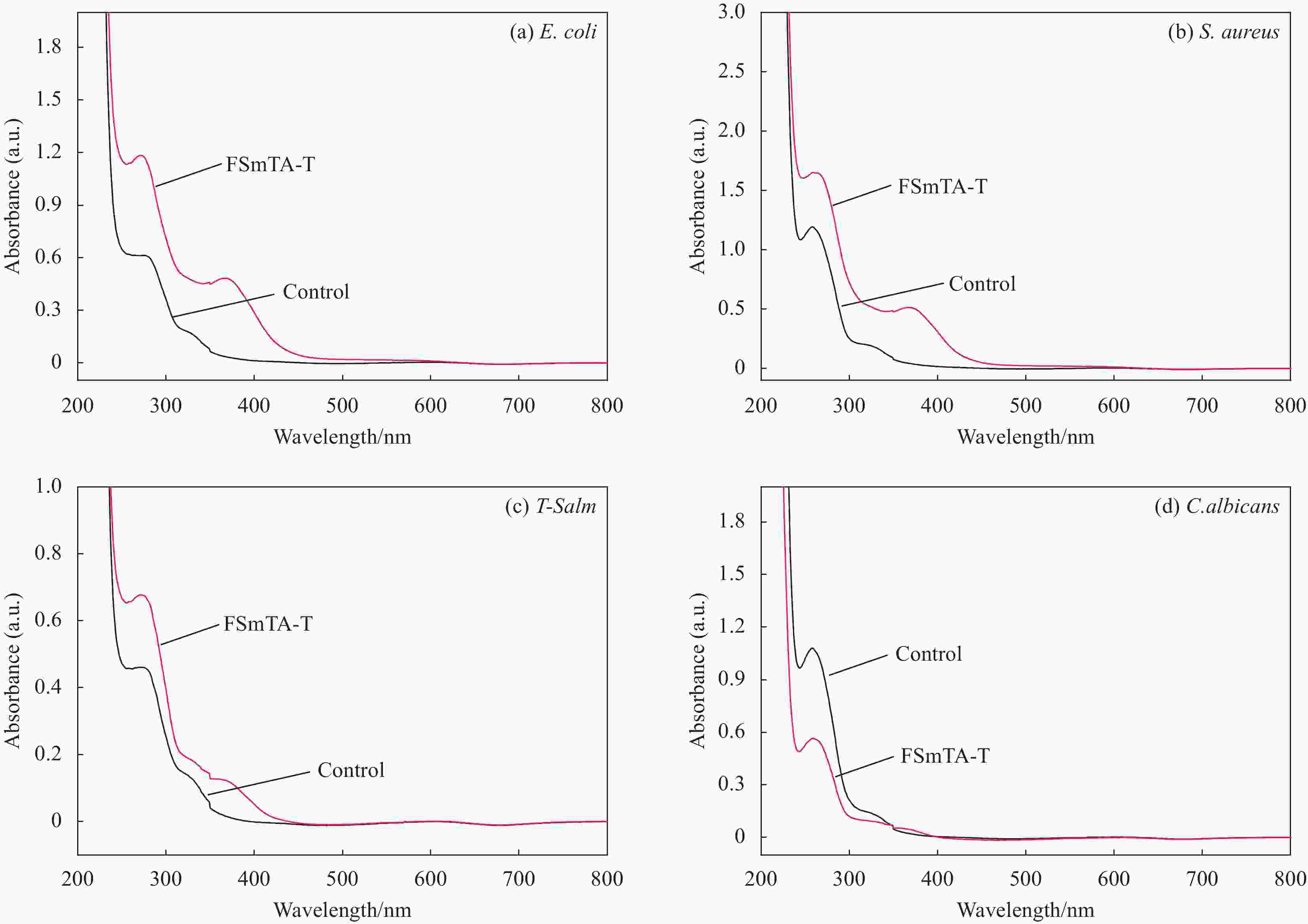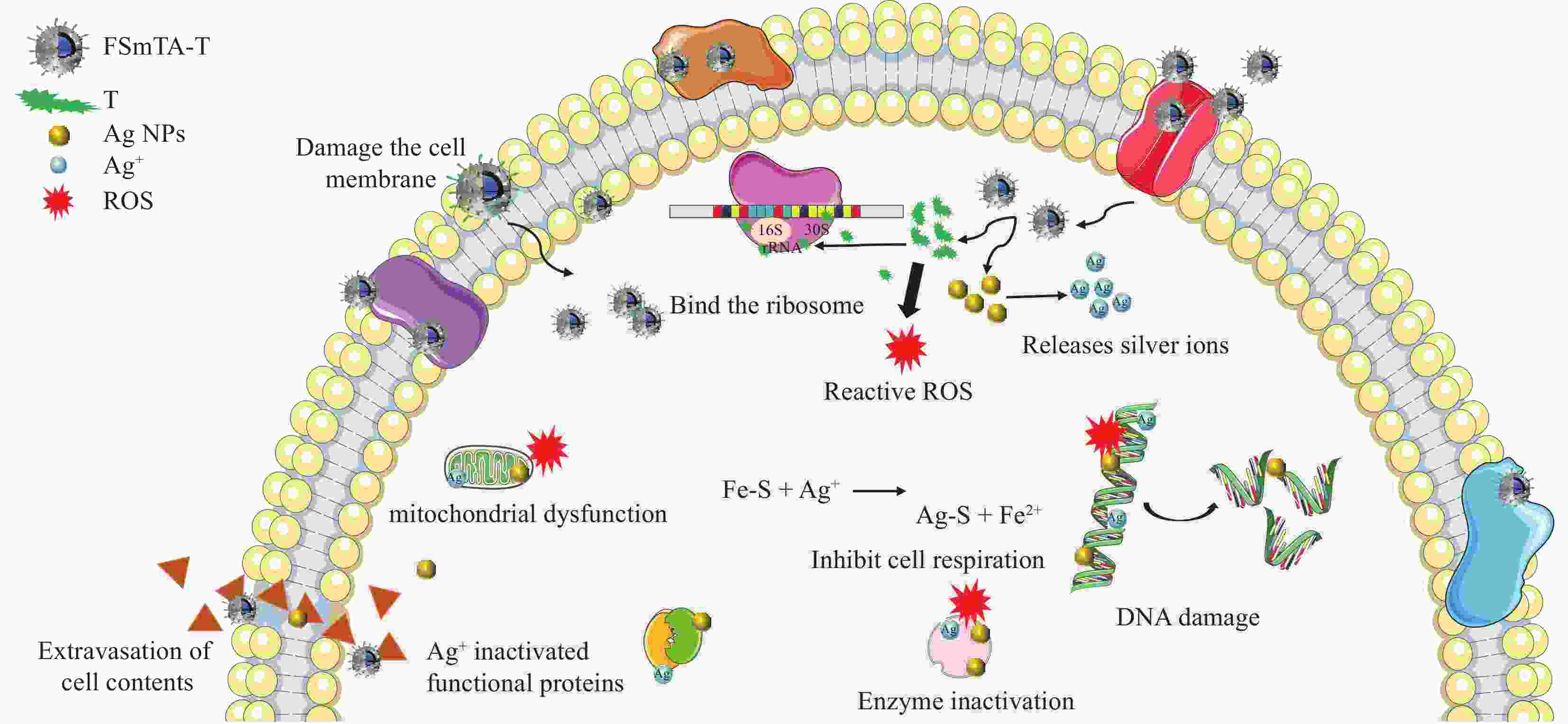Bacteriostatic performance and mechanism of Ag quantum dots synergistic tetracycline
-
摘要: 四环素类抗生素因具有高效、低毒、广谱抑菌性等优点而被广泛使用,但随着抗生素的滥用致使大量的耐药菌出现,使四环素类抗生素的药用价值逐渐降低。超小粒径的纳米Ag虽可使细菌甚至耐药菌失活,但单独使用毒性较强,且易团聚。为此,本研究利用Ag的d轨道为满电子结构,可与供电子基团配位的原理,设计了核壳型介孔Fe3O4@SiO2@mTiO2@Ag-四环素(FSmTA-T)复合材料用以解决抗生素耐药和纳米Ag团聚、强毒性问题。研究结果显示,制备的复合材料中纳米Ag量子点的粒径约为2.84 nm,可与四环素环3中的羰基键合,同时,相比四环素,复合材料对大肠杆菌,金黄色葡萄球菌,耐四环素沙门氏菌和白色念珠菌均具有较高的抑菌活性,并可有效破坏细菌细胞壁而使其死亡,且对哺乳细胞的毒性降低为原来的1/3。因此,其优越的抑菌活性可应用于污水处理领域。Abstract: Tetracycline antibiotics are widely used because of their high efficiency, low toxicity and broad-spectrum bacteriostasis, but with the abuse of antibiotics leading to the emergence of a large number of resistant bacteria, the medicinal value of tetracycline antibiotics gradually decreases. Although the ultra-small particle size of Ag can inactivate bacteria and even drug-resistant bacteria, it is highly toxic and easy to agglomerate when used alone. Therefore, in this study, the core-shell mesoporous Fe3O4@SiO2@mTiO2@Ag-tetracycline (FSmTA-T) composite was designed to solve the problems of antibiotic resistance, Ag nanoparticles agglomeration and strong toxicity by using the principle that the d orbital of Ag is a full electron structure and can be coordinated with the electron donor group. The results showed that the particle size of the Ag quantum dots in the prepared composite was 2.84 nm, which could be bonded with the carbonyl group in tetracycline ring 3, and compared with tetracycline, the composite material had high bacteriostatic activity against Escherichia coli, Staphylococcus aureus, tetracycline-resistant Salmonella and Candida albicans, and could effectively destroy the bacterial cell wall and make it die, while the toxicity was reduced to 1/3 of the original. Therefore, its superior bacteriostatic activity can be applied to sewage treatment.
-
Key words:
- bacteriostasis /
- nanocomposite material /
- antibacterial mechanism /
- tetracycline /
- drug resistance /
- Ag quantum dots
-
图 7 (a-d)是不同材料对E. coli、S. aureus、T-Salm和C. albicans的滤纸片扩散照片,O为对照,A,B,C和D依次为Ag、T、FSmTA和FSmTA-T
Figure 7. Paper diffusion photos of of different samples on E. coli (a), S. aureus (b), T-Salm (c) and C. albicans (d). O is the control, A, B, C and D are Ag、T、FSmTA and FSmTA-T, respectively
a1~e1: 25 µg/mL; a2~e2: 50 µg/mL; a3~e3: 100 µg/mL; a4~e4: 150 µg/mL; a5~e5: 200 µg/mL
图 9 (a)为MIC抑菌数据结果,(b-e)为材料对E. coli、S. aureus、T-Salm和C. albicans滤纸片扩散分析结果数据,(f)为 FSmTA-T对菌的菌落计数分析结果
Figure 9. Antibacterial data results of MIC (a),The results of filter paper diffusion analysis of E. coli (b), S. aureus (c), T-Salm (d) and C. albicans (d) by materials. The FSmTA-T on bacterial colony count analysis data results (f)
图 10 (a1-a4),(b1-b4)分别为FSmTA-T对E. coli、S. aureus、T-Salm 和C. albicans 的PI染色结果,(c)为Zeta电势分析结果,(d)为GDC-0941、T、Ag和FSmTA-T对MCF-7细胞活力的影响
Figure 10. PI staining analysis of FSmTA-T on E. coli (a1, b1), S. aureus (a2, b2), T-salm (a3, b3) and C. albican (a4, b4). Zeta potential analysis results (c). Viability of MCF-7 cells exposed to GDC-0941, T, Ag and FSmTA-T (d)
-
[1] WANG Y F, WANG C H, YAN S, et al. The removal of antibiotic, antibiotic resistant bacteria and genes in persulfate oxidation system via activating by antibiotic fermentation dregs derived biochar[J]. Journal of Cleaner Production, 2023, 394: 136328. doi: 10.1016/j.jclepro.2023.136328 [2] WANG J Q, XU S Q, ZhAO K, et al. Risk control of antibiotics, antibiotic resistance genes (ARGs) and antibiotic resistant bacteria (ARB) during sewage sludge treatment and disposal: A review[J]. Science of The Total Environment, 2023, 877: 162772. doi: 10.1016/j.scitotenv.2023.162772 [3] FANG H, LIU Y H, QIU P X, et al. Simultaneous removal of antibiotic resistant bacteria and antibiotic resistance genes by molybdenum carbide assisted electrochemical disinfection[J]. Journal of Hazardous Materials, 2022, 432: 128733. doi: 10.1016/j.jhazmat.2022.128733 [4] ZHANG Z Q, XU Z N, WANG X G. The greenhouse effect of antibiotics: The influence pathways of antibiotics on methane release from freshwater sediment[J]. Environment International, 2023, 176: 107964. doi: 10.1016/j.envint.2023.107964 [5] WANG S, HE L, ZHANG M Y, et al. Effects of antibiotic resistance genes and antibiotics on the transport and deposition behaviors of bacteria in porous media[J]. Environmental Science & Technology, 2023, 57(28): 10426-10437. [6] YA H B, ZHANG T, XING Y, et al. Co-existence of polyethylene microplastics and tetracycline on soil microbial community and ARGs[J]. Chemosphere, 2023, 335: 139082. doi: 10.1016/j.chemosphere.2023.139082 [7] WANG Q D, XU Q Y, ZHAI S Y, et al. Understanding the coordination behavior of antibiotics: Take tetracycline as an example[J]. Journal of Hazardous Materials, 2023, 460: 132375. doi: 10.1016/j.jhazmat.2023.132375 [8] WU X W, ZHAO X L, WANG X, et al. Bioaccessibility of polypropylene microfiber-associated tetracycline and ciprofloxacin in simulated human gastrointestinal fluids[J]. Environment International, 2023, 179: 108193. doi: 10.1016/j.envint.2023.108193 [9] OSORIO V, MEZQUITA A S, BALCAZAR J L. Comparative metagenomics reveals poultry and swine farming are hotspots for multidrug and tetracycline resistance[J]. Environmental Pollution, 2023, 322: 121239. doi: 10.1016/j.envpol.2023.121239 [10] MA X Q, WEN X, YANG D Q, et al. Collateral sensitivity between tetracyclines and aminoglycosides constrains resistance evolution in carbapenem-resistant Klebsiella pneumoniae[J]. Drug Resistance Updates, 2023, 68: 100961. doi: 10.1016/j.drup.2023.100961 [11] LI H B, FAN Y F, SUN Z L, et al. Abrading-induced breakdown of Ag nanoparticles into atomically dispersed Ag for enhancing antimicrobial performance[J]. Environmental Science & Technology 2023, 57(15): 6150-6158. [12] WANG C Y, ZHU S L, LIANG Y Q, et al. Flexible free-standing antibacterial nanoporous Ag ribbon[J]. Journal of Colloid and Interface Science, 2023, 645: 287-296. doi: 10.1016/j.jcis.2023.04.153 [13] SUN X D, PAN W H, WANG G, et al. Ag nanoparticle and Ti–MOF cooperativity for efficient inactivation of E. coli in Water[J]. ACS Applied Materials & Interfaces, 2023, 15(37): 43712-43723. [14] ZHANG J, SINGH P, CAO Z J, et al. Polydopamine/graphene oxide coatings loaded with tetracycline and green Ag nanoparticles for effective prevention of biofilms[J]. Applied Surface Science, 2023, 626: 157221. doi: 10.1016/j.apsusc.2023.157221 [15] YAN J H, WANG Q F, YANG J L, et al. Chemical Synthesis of Innovative Silver Nanohybrids with Synergistically Improved Antimicrobial Properties[J]. International Journal of Nanomedicine, 2023, 18: 2295-2305. doi: 10.2147/IJN.S405255 [16] SHI J, ZHENG J L, LIANG B, et al. Silver-decorated amino-modified Fe3O4@SiO2@mTiO2 core-shell nanocomposites with catalytic and antimicrobial bifunctional activity[J]. Colloids and Surfaces A:Physicochemical and Engineering Aspects, 2023, 668: 131402. doi: 10.1016/j.colsurfa.2023.131402 [17] JI X H, WU Y H, HAN Y Y, et al. Synergistic antibacterial study of nano-Cu2O/CuO@Ag-tetracycline composites[J]. Materials Chemistry and Physics, 2023, 306: 127904. doi: 10.1016/j.matchemphys.2023.127904 [18] ZHOU Z B, XIAO J W, HUANG S, et al. A wet-adhesive carboxymethylated yeast β-glucan sponge with radical scavenging, bacteriostasis and anti-inflammatory functions for rapid hemostasis[J]. International Journal of Biological Macromolecules, 2023, 230: 123158. doi: 10.1016/j.ijbiomac.2023.123158 [19] JIN Y Y, WANG C, XIA Z Y, et al. Photodynamic chitosan sponges with dual instant and enduring bactericidal potency for treating skin abscesses[J]. Carbo hydrate Polymers, 2023, 306: 120589. doi: 10.1016/j.carbpol.2023.120589 [20] CUI J Y, WAN M H, WANG Z H, et al. Preparation of PAN/SiO2/CTAB electrospun nanofibrous membranes for highly efficient air filtration and sterilization[J]. Separation and Purification Technology, 2023, 321: 124270. doi: 10.1016/j.seppur.2023.124270 [21] ONG T H D, Yu N, MEENASHISUNDARAM G K, et al. Insight into cytotoxicity of Mg nanocomposites using MTT assay technique[J]. Materials Science and Engineering:C, 2017, 78: 647-652. doi: 10.1016/j.msec.2017.04.129 [22] LU J, ZHOU Y, ZHOU Y B. Efficiently activate peroxymonosulfate by Fe3O4@MoS2 for rapid degradation of sulfonamides[J]. Chemical Engineering Journal, 2021, 422: 130126. doi: 10.1016/j.cej.2021.130126 [23] WANG L, SAGAGUCHI T, OKUHATA T, et al. Electron and phonon dynamics in hexagonal Pd nanosheets and Ag/Pd/Ag sandwich nanoplates[J]. ACS Nano, 2017, 11(2): 1180-1188. doi: 10.1021/acsnano.6b07082 [24] WOOLSTON B M. , STEPHANOPOULOS G. Engineering E. coli to grow on methanol[J]. Joule, 2020, 4(10): 2070-2072. doi: 10.1016/j.joule.2020.09.019 [25] GREENHILL C. Role for S. aureus in insulin resistance[J]. Nature Reviews Endocrinology, 2018, 14: 381. [26] CHIN Voon, LEE T, RUSLIZA B, et al. Dissecting Candida albicans infection from the perspective of C. albicans virulence and omics approaches on host–pathogen interaction: A review[J]. International Journal of Molecular Sciences, 2016, 17(10): 1643. doi: 10.3390/ijms17101643 [27] QIAN L W, LEI D, DUAN X, et al. Design and preparation of metal-organic framework papers with enhanced mechanical properties and good antibacterial capacity[J]. Carbohydrate Polymers, 2018, 192: 44-51. doi: 10.1016/j.carbpol.2018.03.049 [28] XU X, LI Y L, WANG L X, et al. Triple-functional polyetheretherketone surface with enhanced bacteriostasis and anti-inflammatory and osseointegrative properties for implant application[J]. Biomaterials, 2019, 212: 98-114. doi: 10.1016/j.biomaterials.2019.05.014 [29] MALGORZATA O R, WALDEMAR P, AGNIESZKA O S. Tetracyclines-an important therapeutic tool for dermatologists[J]. International Journal of Environmental Research and Public Health, 2022, 19(12): 7246. doi: 10.3390/ijerph19127246 -

 点击查看大图
点击查看大图
计量
- 文章访问数: 72
- HTML全文浏览量: 43
- 被引次数: 0





 下载:
下载:
